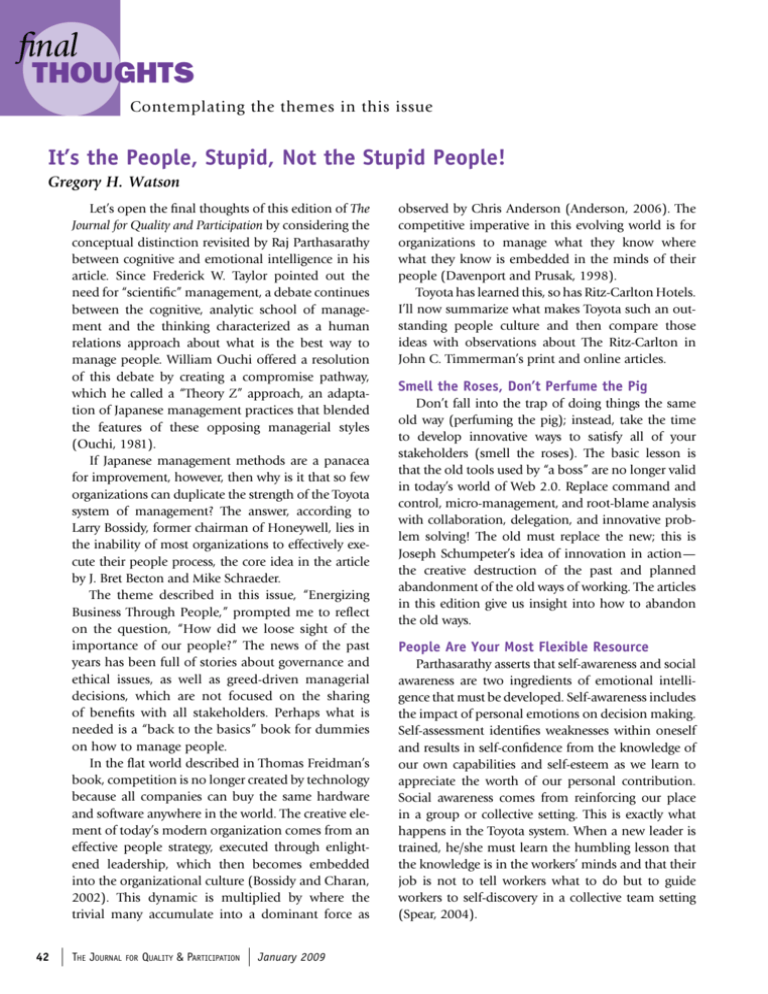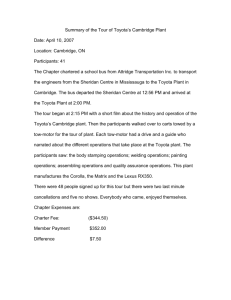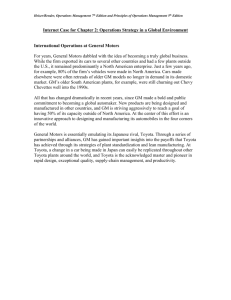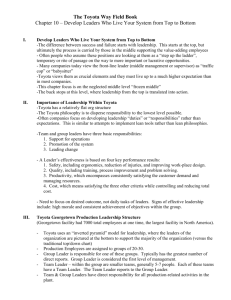thoughts - Gregory H. Watson
advertisement

final thoughts Contemplating the themes in this issue It’s the People, Stupid, Not the Stupid People! Gregory H. Watson Let’s open the final thoughts of this edition of The Journal for Quality and Participation by considering the conceptual distinction revisited by Raj Parthasarathy between cognitive and emotional intelligence in his article. Since Frederick W. Taylor pointed out the need for “scientific” management, a debate continues between the cognitive, analytic school of management and the thinking characterized as a human relations approach about what is the best way to manage people. William Ouchi offered a resolution of this debate by creating a compromise pathway, which he called a “Theory Z” approach, an adaptation of Japanese management practices that blended the features of these opposing managerial styles (Ouchi, 1981). If Japanese management methods are a panacea for improvement, however, then why is it that so few organizations can duplicate the strength of the Toyota system of management? The answer, according to Larry Bossidy, former chairman of Honeywell, lies in the inability of most organizations to effectively execute their people process, the core idea in the article by J. Bret Becton and Mike Schraeder. The theme described in this issue, “Energizing Business Through People,” prompted me to reflect on the question, “How did we loose sight of the importance of our people?” The news of the past years has been full of stories about governance and ethical issues, as well as greed-driven managerial decisions, which are not focused on the sharing of benefits with all stakeholders. Perhaps what is needed is a “back to the basics” book for dummies on how to manage people. In the flat world described in Thomas Freidman’s book, competition is no longer created by technology because all companies can buy the same hardware and software anywhere in the world. The creative element of today’s modern organization comes from an effective people strategy, executed through enlightened leadership, which then becomes embedded into the organizational culture (Bossidy and Charan, 2002). This dynamic is multiplied by where the trivial many accumulate into a dominant force as 42 The Journal for Quality & Participation January 2009 observed by Chris Anderson (Anderson, 2006). The competitive imperative in this evolving world is for organizations to manage what they know where what they know is embedded in the minds of their people (Davenport and Prusak, 1998). Toyota has learned this, so has Ritz-Carlton Hotels. I’ll now summarize what makes Toyota such an outstanding people culture and then compare those ideas with observations about The Ritz-Carlton in John C. Timmerman’s print and online articles. Smell the Roses, Don’t Perfume the Pig Don’t fall into the trap of doing things the same old way (perfuming the pig); instead, take the time to develop innovative ways to satisfy all of your stakeholders (smell the roses). The basic lesson is that the old tools used by “a boss” are no longer valid in today’s world of Web 2.0. Replace command and control, micro-management, and root-blame analysis with collaboration, delegation, and innovative problem solving! The old must replace the new; this is Joseph Schumpeter’s idea of innovation in action— the creative destruction of the past and planned abandonment of the old ways of working. The articles in this edition give us insight into how to abandon the old ways. People Are Your Most Flexible Resource Parthasarathy asserts that self-awareness and social awareness are two ingredients of emotional intelligence that must be developed. Self-awareness includes the impact of personal emotions on decision making. Self-assessment identifies weaknesses within oneself and results in self-confidence from the knowledge of our own capabilities and self-esteem as we learn to appreciate the worth of our personal contribution. Social awareness comes from reinforcing our place in a group or collective setting. This is exactly what happens in the Toyota system. When a new leader is trained, he/she must learn the humbling lesson that the knowledge is in the workers’ minds and that their job is not to tell workers what to do but to guide workers to self-discovery in a collective team setting (Spear, 2004). Bossidy identified the people process as the key for translating the content of the strategy process (strategic intent and plans) into the operating process of the organization. This is the role that Becton and Schraeder describe as the evolving need for strategic human resources in their article. Perhaps a good example from a respected company can help to illustrate the pragmatic aspects of this linkage. Let’s consider how the Toyota Motor Company makes better use of human capital than its competitors by summarizing the company’s people-engaging processes below: • Workers are responsible for the quality of their work. • Workers share responsibility for the throughput rate of their processes. • Workers are responsible for improving the quality of work. • Workers are granted decision rights to stop production if the quality is not right. • Workers are trained in their processes, provided tools to do the job right, and given achievable goals to deliver the throughput requirements of customers. • Workers are encouraged to participate in improving their machine operations as well as routine maintenance and cross training of their co-workers. • Workers are encouraged to experiment (under supervision of a coach) with process improvements that will decrease cost and defects, eliminate waste, improve cycle time, or enhance safety. Why did Toyota develop this strategic human resource management focus? Perhaps it is because of the insight of its senior leaders. Toyota’s long-term vice president of manufacturing, Taiichi Ohno, who is acknowledged as the architect of just-in-time (JIT) and the Toyota Production System (TPS), recognized that the most deadly waste in an organization is the waste of human intellect! When his workers presented him with a list of wastes, he observed that one was missing. This idea is captured in Timmerman’s article about The Ritz-Carlton as he emphasizes that people are not just “hands” to hire, but they also are “heads” and “hearts” to engage and win. Human Capital Can Reduce the Need for Investment Capital Some have observed that President-elect Barack Obama made an innovative use of Web 2.0 type of communication and gained votes and support through a long-tail phenomenon, where the mass of small supporters overwhelms the massive contributions of the “vital few” (and therefore politically influential) large supporters. One clear lesson of this election is that the people are not a “trivial many!” If we challenge our people to more creatively apply the capital already invested in our businesses, then we can address the current financial crisis with a more positive attitude and discover innovative approaches; however, if we seek to cover our past mistakes and poor investments with just more money, then we will only exacerbate the situation and waste further resources. The solution to the problems of today is found in a more effective engagement of our people. Synergies and Idiosyncrasies Are Both Necessities Recent Web debates discussing Albert Einstein raise a key question: Should we develop the individual genius or rely on “institutional” thinking and the power of the collective mind? We can focus synergies gained by bringing people together in one of two ways: developing standard work or developing innovative ways to do things (thereby creating new standards). For those who don’t believe that the lessons learned in manufacturing can apply to their businesses, study how The Ritz-Carlton’s respect for people and strong recognition of the value of people as a renewable resource can change the way an organization operates and gain the lasting favor of their customers. We can conclude that while genius is a necessary ingredient for success, it is not a sufficient one—unless we add the collective wisdom for innovative implementation of its ideas and creativity. Lessons Once Learned Should Not Be Forgotten During the decade of the 1980s, Hewlett-Packard (HP) investigated many of these same issues related to the problem of managing people in teams and developed a process to help focus on the actions required to manage at all levels—a process of management (POM). HP created a five-step process that is applicable in many different organizations, no matter what the content of the process managed, because it focuses on enabling the people aspect of the process. • Establish a mutual purpose and direction —Communicate with customers, study the environment, align with organizational objectives, be open to innovation, and analyze and integrate data. • Build a common vision —Involve people in building the vision, define a collaborative way of working, communicate the vision, and maintain alignment. www.asq.org/pub/jqp 43 • Develop shared plans —Use effective planning techniques, identify appropriate resources, and develop a spirit of shared responsibility. • Lead the course of action —Facilitate the activities, review progress regularly, give and solicit feedback, support and develop people, lead by example, and recognize and reward contribution. Thomas H. Davenport and Laurence Prusak, Working Knowledge, Harvard Business School Press, 1998. Steven J. Spear, “Learning to Lead at Toyota,” Harvard Business Review, May 2004. • Evaluate results and process —Determine customer and company satisfaction, review the process, identify opportunities for improvement, and celebrate successes. Sharing My Viewpoint as the Final Thought I found the articles in this issue provocative. I don’t believe that many people arrive at work seeking to fail; however, I do believe that we can condition people to ignore opportunities for improvement and to become insensitive to the potential for progress. These are issues about personal commitment and motivation, which are natural outcomes from the ideas expounded in this issue. We should consider three basic questions related to personal commitment and motivation as we seek to lead our organizations to innovate in these very troubled times: Gregory Watson is past-president of ASQ. He is chairman of Business Excellence Solutions, Ltd. located in Finland. Watson is also president-elect of the International Academy for Quality. In 2000, his peers in the quality community elected him as one of Quality Progress magazine’s global “21 Voices of Quality in the 21st Century.” He has served as the primary author for the scenarios used to analyze the five prior ASQ Futures Studies (printed in 1996, 1999, 2002, 2005, and 2008). He can be contacted at gregbss@aol.com. • If not this, then what? Have we clearly established our priority for what must be accomplished so we are focusing on the vital few things that will engage the trivial many people (the ones who are sitting in the “long tail” of the distribution) to effectively accomplish our true imperatives? social • If not me, then who? Have we clearly accepted responsibility for what we must do? Are we effective stewards of what we must delegate and do we provide an approach for achieving the desired state? Did You Know? • If not now, then when? Have we developed a realistic schedule for coordinating the use of our renewable “people” resource to efficiently and economically achieve the desired outcome of our coordinated activities? I hope that you get as much stimulation for your thinking out of the articles in this issue as I did. References: William G. Ouchi, Theory Z, Addison-Wesley, 1981. Thomas L. Friedman, The World is Flat, Straus and Giroux, 2006. Chris Anderson, The Long Tail, Hyperion, 2006. Larry Bossidy and Ram Charan, Execution: The Discipline of Getting Things Done, Crowne Business, 2002. 44 Gregory Watson The Journal for Quality & Participation January 2009 responsibility Suppose every American home replaced one incandescent light bulb with an energy-efficient fluorescent bulb? ENERGY STAR, a joint program of the U.S. Environmental Protection Agency and the U.S. Department of Energy, reports that our country “would save enough energy to light more than 3 million homes for a year, more than $600 million in annual energy costs, and prevent greenhouse gases equivalent to the emissions of more than 800,000 cars.” Compact fluorescent lights (CFLs) use about 75 percent less energy, reducing electricty usage about $30 over their lifetimes. They work most effectively in fixtures that remain lighted for long periods of each day, which makes them a great fit for offices. See www.energystar.gov/ index.cfm?c=cfls.pr_cfls for more information.






